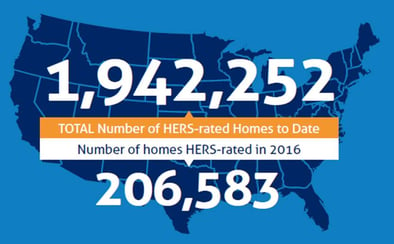 Among the many factors consumers should consider when buying a home is the cost of ownership -- recurring expenses that are variable and not always obvious. One of those is energy costs, which are estimated to consume up to 4% (roughly $2,200 per year) of the average household’s income, before taxes.[1] Building more energy efficient homes, however, has helped decrease electricity demand, which was down 1.1% in 2016.[2] That’s certainly great news, but many consumers in the market for a home have little or no information on the energy efficiency of homes they may be interested in buying. A new effort by Residential Energy Services Network (RESNET) and the Appraisal Institute, the association of professional real estate appraisers, will make home energy efficiency more transparent to buyers.
Among the many factors consumers should consider when buying a home is the cost of ownership -- recurring expenses that are variable and not always obvious. One of those is energy costs, which are estimated to consume up to 4% (roughly $2,200 per year) of the average household’s income, before taxes.[1] Building more energy efficient homes, however, has helped decrease electricity demand, which was down 1.1% in 2016.[2] That’s certainly great news, but many consumers in the market for a home have little or no information on the energy efficiency of homes they may be interested in buying. A new effort by Residential Energy Services Network (RESNET) and the Appraisal Institute, the association of professional real estate appraisers, will make home energy efficiency more transparent to buyers.
Making the Invisible Visible
“One of the largest barriers to the building and selling of high energy performance homes is that the value of energy upgrades is too often not reflected in the real estate appraisal of a home,” said RESNET Executive Director Steve Baden. “Many of the features that make a home energy efficient are hidden behind drywall and aren’t obvious to home buyers. Our goal is to make information, such as the HERS score of a home, visible in the appraisal so that consumers have more facts available to make their decisions.”
Through an addendum covering elements of the home considered “green,” such as additional insulation, the Appraisal Institute identifies these items and includes them into the valuation of the property. Working with RESNET, the HERS score of the home is being added as a green building certification element that will be included among the other home certification options, such as LEED for Homes.
The Appraisal Institute will have access to RESNET’s database of HERS-rated homes. Initially, access will be available in states with a large number of HERS-rated homes, such as Texas, which has the highest number of HERS-rated homes at 40,012 and counting. More states will be added over time. In 2016, there were more than 206,000 HERS-rated homes nationally, 16,000 more than in 2015.
Properly Valuing Energy Efficient Homes
For builders who may be skeptical about the value of constructing high energy performance homes this effort may signal the removal of a barrier to their construction. “When a feature of a home being sold is not recognized in the appraisal, it means that the features cannot be financed through the home’s mortgage loan,” Baden noted. “Often the builder has to ‘eat’ the added cost for high performance or the buyer has to pay for the improvements out of pocket. Having the energy performance of the homes recognized in the appraisal means they can be financed through the mortgage loan, which reduces out-of-pocket costs to the owners.” The added bonus, of course, is that a high energy performance home is more comfortable and has lower energy costs than standard builds.
“The technology is there, the economics are good and NAHB research has shown that consumers want energy efficient homes. It’s time that we made this information more transparent to consumers so that they can have as much information as possible to make that critical home-purchase decision,” Baden said.
[1] American Coalition for Clean Coal Electricity
[2] Business Council for Sustainable Energy Factbook 2017





